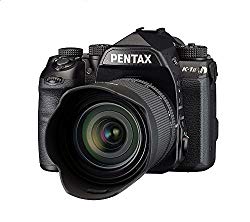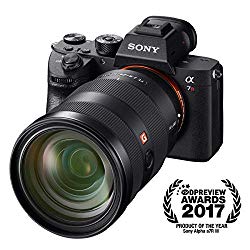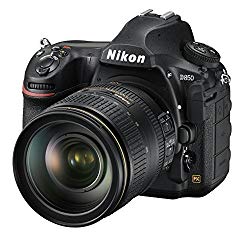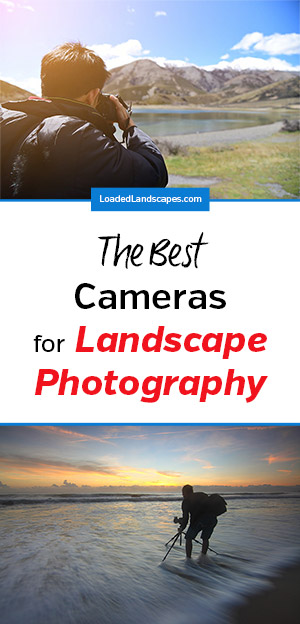
Photo by Tirachard Kumtanom / CC0
Your camera body is a huge part of your photography, of course. And choosing the right landscape camera can be tricky. So let’s take a look at some of the best cameras for landscape photographers on the market today and see which one would work best for you!

![]()
Available body-only or with the with the D_FA 28.105mm WR Lens
In my opinion, this is THE camera for landscape photography. It has everything you could possibly want and then some. The 36.4-megapixel full-frame image sensor is well balanced between resolution and low light needs. Landscape images benefit from having extra resolution to bring out all of the fine details in, say, a mountain or a forest in the distance.
We also want resolution beyond the usual 24-megapixels because landscape photographs are particularly well suited to making large prints. The full-frame sensor of the K-1 Mark II gives us a marvelous field of view paired with a wide angle lens that cropped sensors naturally won’t have.
The magnesium-alloy body is durable and weather resistant to ensure the camera can handle as much of the elements as you can. Weatherized doesn’t mean you can immerse it in water but splashes from rain or dust storms shouldn’t penetrate the body. You’ll need to ensure the lens is also weatherized. Fortunately, the kit lens for the K-1 is a WR (weather resistant) lens to get you started.
The K-1 Mark II has a Pixel Shift mode that’s becoming increasingly popular in mid-high end interchangeable lens cameras. This mode is meant to be used on static subjects while mounted to a tripod. The sensor shifts four times in order to gather the maximum amount of color and luminance data for each pixel. The images are then combined into a super-high resolution composite image. Given the large megapixel count of the K-1 Mark II, this could mean RAW file sizes as unwieldy as 80-100MB or more. But if you want to maximize image quality on a static landscape this is a marvelous trick.
A movable sensor also means the K-1 has more tricks to offer. The sensor uses 5-axis stabilization to ensure handheld shots aren’t ruined by motion blur. According to Pentax, the stabilization is adjustable to as many as 5 shutter speed stops. Say I need to use a shutter speed of 1/8000ths of a second to avoid motion blur using a particular camera. With the stabilization of the K-1 Mark II, I can shoot as slow as 1/500ths of a second and have the same chance of motion blur! Adjustable stabilization is good since it uses additional battery power.
Pentax includes yet another moving sensor trick with its Astrotracer feature. Astrophotographers should rejoice as the K-1 Mark can lock onto GPS signals to physically move the sensor with the rotation of the earth, allowing for Bulb Mode long exposures beyond 30 seconds. The ISO also can be cranked up as high as an incredible 819,200. Not that you’d want to be shooting at such an extreme range very often, but the low-light capacity of the sensor is excellent overall.
These are just the major goodies that the Pentax K-1 Mark II has to offer. There’s a huge list of minor ones as well. Dual card slots, backlighting for buttons at night, flexible tilt LCD screen, ISO-invariance…It’s definitely one of the best landscape cameras on the market.
There are a few drawbacks to this particular camera. For one, it’s quite chunky, even for a DSLR. The physical dimensions are only slightly larger than most but at 1010 g (2.23 lb / 35.63 oz) this is a hefty beast of a tool, comparable to the Nikon D850. But unlike the Nikon, Pentax has never been a hugely popular brand and there are relatively few lenses available for it. Only 144 lenses natively fit with it. Finding extra lenses can be something of a challenge if you’re not shopping online. Lastly, at 670 shots per charge, it actually has less stamina than the original K-1 but remains acceptable for a DSLR. Still, considering how relatively little innovation Nikon and Canon have been providing recently, it’s nice to see a DSLR of this caliber for such a reasonable price!
Find the Best Price at Amazon.

![]()
Available body-only or with 24-70mm f/4 Vario-Tessar T FE OSS Kit Lens
Next comes another weatherized offering. Sony tends to back off from calling their gear fully “weather-proof” as reports have come in suggesting that the seals do fail on occasion. But for shooting in light rain and dusty environments the Sony A7RIII is one of the best cameras you can have! The magnesium alloy body is durable and resistant to wear.
The 42.4 MP full-frame sensor the A7RIII uses is very well suited to landscape photography, thanks to the large uncropped field of view. The wide angle portion of the kit lens makes it a good landscape photography camera right out of the box. Still, a bit more of a wide angle field of view helps for full scene coverage. The Sony SEL1018 f/4 10-18mm Wide-Angle Zoom Lens is a great choice here.
Outdoor videographers will find the Sony A7RIII is the best choice here thanks to the 4K video resolution (3840 x 2160p at 30 fps). The Pentax K-1 maxes out at Full HD (1920 x 1080p at 60 fps). While the Nikon also does 4K at 30 fps it doesn’t have Log recording which contains the maximum amount of color rendition data (think RAW format for videography).
Overall, the A7RIII has a great chassis, just as nice as that of the K-1 Mark II or D850. It has the same Pixel Shift mode as the Pentax thanks to it’s stabilized sensor, though again that means much larger file sizes.
The sensor stabilization provides just as much motion blur protection that extends to every lens paired with the camera. And as a mirrorless camera it’s significantly smaller than either of the DSLRs here. At 127 x 96 x 74 mm (5 x 3.78 x 2.91″) it’s around 1/2 to 3/4ths of an inch smaller on every dimension compared to either DSLR and at 657 g (1.45 lb / 23.17 oz) nearly 350 grams lighter as well. When weight really matters the Sony A7RIII will make for a far more compact kit to work with.
But it’s main drawback as a landscape camera is that it has few features specific to landscape photography and that it’s significantly more expensive than the Pentax. However, at 650 shots per battery charge, it compares favorably with the K-1 but not with the D850 (1840 shots).
Find the Best Price at Amazon

![]()
Available body only or with the 24-120 MM Lens
Last but certainly not least is the Nikon D850. It sports a high-resolution 46-megapixel on a generously sized full-frame sensor. And like the other two it is fully weatherized to prevent moisture or dust from ruining your outdoor photography adventure.
Of all the cameras here the D850 also has by far the largest number of available lenses thanks to being part of the Nikon continuum of cameras. Over 286 lenses natively work with the D850 compared to 144 with the K-1 Mark II and 83 with the Sony A7RIII. At 1005 g (2.22 lb / 35.45 oz) it weighs the same as the Pentax but far more than the A7RIII.
Like most Nikon DSLRs the battery life is excellent. At 1840 shots per charge the D850 can easily see you through two or more shoots before needing a recharge. It brings nearly 3x the stamina compared to the K-1 and A7RIII.
One major drawback is that the D850 doesn’t have the sensor stabilization that the other two cameras provide. Many Nikon lenses still come with image stabilization (VR – vibration reduction) but it only works with each individual lens and usually doesn’t provide as many stops of stabilization. And with 151 autofocus points for composition, the D850 has quite a few more than the K-1 Mark II (33 AF points) but not nearly as much as the Sony A7RIII (425 AF points).
Find the Best Price at Amazon.
Conclusion
Each of these cameras has something for everyone. The D850 is the best choice for photographers who already have a large selection of Nikon lenses and don’t want to swap brands. Also, if sensor resolution is of the utmost importance the D850 comes out on top. But the other two cameras here also have more resolution than average. In terms of features, landscape photographers would want the K-1 Mark II probably wins outright. It’s also significantly cheaper than either the Sony or Nikon offerings. And in terms of portability (travel photographers take note) the Sony A7RIII is your best bet. Happy snapping!
